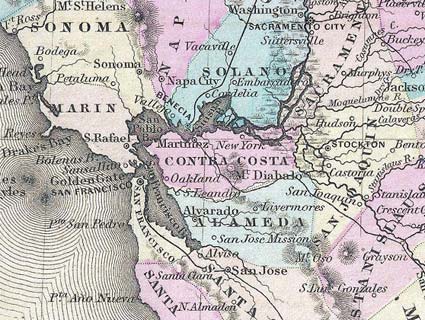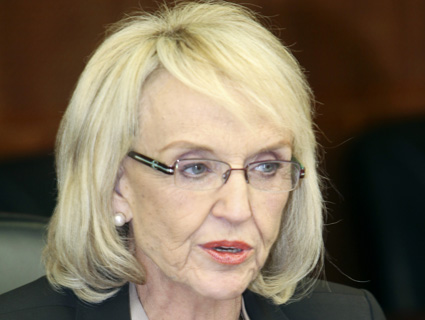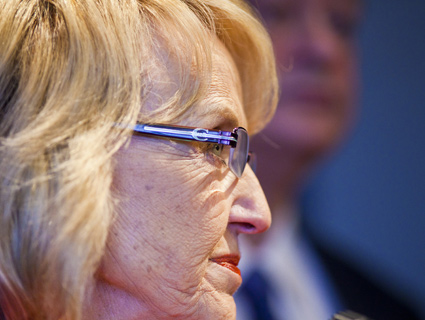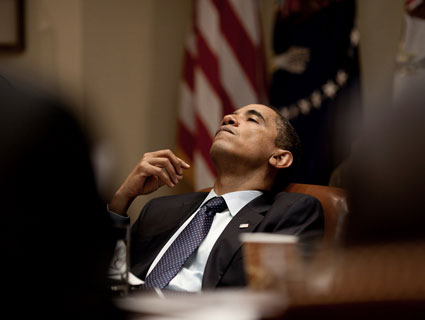
Wikimedia Commons
This story first appeared on the ProPublica website.
This spring, a group of California Democrats gathered at a modern, airy office building just a few blocks from the U.S. Capitol. The meeting was House members only—no aides allowed—and the mission was seemingly impossible.
In previous years, the party had used its perennial control of California’s state Legislature to draw district maps that protected Democratic incumbents. But in 2010, California voters put redistricting in the hands of a citizens’ commission where decisions would be guided by public testimony and open debate.
The question facing House Democrats as they met to contemplate the state’s new realities was delicate: How could they influence an avowedly nonpartisan process? Alexis Marks, a House aide who invited members to the meeting, warned the representatives that secrecy was paramount. “Never say anything AT ALL about redistricting—no speculation, no predictions, NOTHING,” Marks wrote in an email. “Anything can come back to haunt you.”
In the weeks that followed, party leaders came up with a plan. Working with the Democratic Congressional Campaign Committee—a national arm of the party that provides money and support to Democratic candidates—members were told to begin “strategizing about potential future district lines,” according to another email.
The citizens’ commission had pledged to create districts based on testimony from the communities themselves, not from parties or statewide political players. To get around that, Democrats surreptitiously enlisted local voters, elected officials, labor unions and community groups to testify in support of configurations that coincided with the party’s interests.
When they appeared before the commission, those groups identified themselves as ordinary Californians and did not disclose their ties to the party. One woman who purported to represent the Asian community of the San Gabriel Valley was actually a lobbyist who grew up in rural Idaho, and lives in Sacramento.
In one instance, party operatives invented a local group to advocate for the Democrats’ map.
California’s Democratic representatives got much of what they wanted from the 2010 redistricting cycle, especially in the northern part of the state. “Every member of the Northern California Democratic Caucus has a ticket back to DC,” said one enthusiastic memo written as the process was winding down. “This is a huge accomplishment that should be celebrated by advocates throughout the region.”
Statewide, Democrats had been expected to gain at most a seat or two as a result of redistricting. But an internal party projection says that the Democrats will likely pick up six or seven seats in a state where the party’s voter registrations have grown only marginally.
“Very little of this is due to demographic shifts,” said Professor Doug Johnson at the Rose Institute in Los Angeles. Republican areas actually had higher growth than Democratic ones. “By the numbers, Republicans should have held at least the same number of seats, but they lost.”
As part of a national look at redistricting, ProPublica reconstructed the Democrats’ stealth success in California, drawing on internal memos, emails, interviews with participants and map analysis. What emerges is a portrait of skilled political professionals armed with modern mapping software and detailed voter information who managed to replicate the results of the smoked-filled rooms of old.
The losers in this once-a-decade reshaping of the electoral map, experts say, were the state’s voters. The intent of the citizens’ commission was to directly link a lawmaker’s political fate to the will of his or her constituents. But as ProPublica’s review makes clear, Democratic incumbents are once again insulated from the will of the electorate.
Democrats acknowledge that they faced a challenge in getting the districts they wanted in densely populated, ethnically diverse Southern California. The citizen commission initially proposed districts that would have endangered the political futures of several Democratic incumbents. Fighting back, some Democrats gathered in Washington and discussed alternatives. These sessions were sometimes heated.
“There was horse-trading throughout the process,” said one senior Democratic aide.
The revised districts were then presented to the commission by plausible-sounding witnesses who had personal ties to Democrats but did not disclose them.
Commissioners declined to discuss the details of specific districts, citing ongoing litigation. But several said in interviews that while they were aware of some attempts to mislead them, they felt they had defused the most egregious attempts.
“When you’ve got so many people reporting to you or making comments to you, some of them are going to be political shills,” said commissioner Stanley Forbes, a farmer and bookstore owner. “We just had to do the best we could in determining what was for real and what wasn’t.”
Democrats acknowledge the meetings described in the emails, but said the gatherings “centered on” informing members about the process. In a statement to ProPublica, Rep. Zoe Lofgren, head of California’s delegation, said that members, “as citizens of the state of California, were well within their rights to make comments and ensure that voices from communities of interest within their neighborhoods were heard by the Commission.”
“The final product voted on by the Commission was entirely out of the hands of the Members,” said Lofgren. “They, like any other Californian, were able to comment but had no control over the process.”
“At no time did the Delegation draw up a statewide map,” Lofgren said. (Read Lofgren’s full statement.)
California’s Republicans were hardly a factor. The national GOP stayed largely on the sidelines, and individual Republicans had limited success influencing the commission.
“Republicans didn’t really do anything,” said Johnson. “They were late to the party, and essentially non-entities in the redistricting process.”
Fed-up voters create a commission
The once-a-decade redistricting process is supposed to ensure that every citizen’s vote counts equally.
In reality, politicians and parties working to advance their own interests often draw lines that make an individual’s vote count less. They create districts dominated by one party or political viewpoint, protecting some candidates (typically incumbents) while dooming others. They can empower a community by grouping its voters in a single district, or disenfranchise it by zigging the lines just so.
Over the decades, few party bosses were better at protecting incumbents than California’s Democrats. No Democratic incumbent has lost a Congressional election in the nation’s most populous state since 2000.
As they drew the lines each decade, California’s party bosses worked in secret. But the oddly shaped districts that emerged from those sessions were visible for all to see. Bruce Cain, a legendary mapmaker who now heads the University of California’s Washington center, once drew an improbable-looking state assembly district that could not be traversed by car. (It crossed several impassable mountains.)
Cain proudly told the story of the district, which was set up for one of the governor’s friends. Cain said he justified the odd shape by saying it pulled together the state’s largest population of endangered condors. “It wasn’t legitimate on any level,” Cain recalled.
The 2010 ballot initiative giving the citizen commission authority over Congressional districts was sold to voters as a game changer. Not surprisingly, it was strenuously opposed by California’s Democrats, who continue to control the Statehouse.
No fewer than 35 Democratic politicians—including Minority Leader Nancy Pelosi—and their allies spent a total of $7 million to campaign against the proposition. The effort included mailings from faux community groups that derided the commission’s $1 million annual budget as “bureaucratic waste.” Despite this effort, Californians voted 61 percent to 39 percent to wrest federal redistricting from the hands of state lawmakers.
Immediately, Democrats began organizing to influence the citizen commission. There were numerous opportunities.
According to civics textbooks, the aim of redistricting is to group “communities of interest” so that residents in a city, neighborhood or ethnic group wield political power by voting together. The commission took an expansive view of this concept, ultimately defining a “community of interest” as anything from a neighborhood to workers on the same commute, or even areas sharing “intense beach recreation.”
This gave savvy players an opening to draw up maps that benefited one party or incumbent and then find—or concoct—”communities of interest” that justified them.
Democrats set out to do exactly that.
On March 16, members of the California delegation gathered at Democratic Party offices to discuss how to handle redistricting. They agreed that congressmen from the various regions of California—North, South and Central—would meet separately to “create a plan of action,” according to an email recounting the day’s events by Alexis Marks, the House aide. Among the first tasks, Marks wrote, was determining “how to best organize communities of interest.”
Democrats were already working “BEHIND THE SCENES” to “get info out” about candidates for the job of commission lawyer who were viewed as unfriendly. “I’ll keep you in the loop, but do not broadcast,” Marks wrote.
“The CA delegation has been broken down into regions that will be discussing redistricting at the member level,” read another party email from late March. “Members will be asked to present ideas on both issues”—communities of interest and district lines—”and will be asked to come to some consensus about how to adopt a regional strategy for redistricting.”
Over the next several weeks, California Democrats huddled with Mark Gersh, the party’s top mapmaking guru. Officially, Gersh works with the Foundation for the Future, a nonprofit whose declared goal is “to help Democrats get organized for the fight of the decade; the fight that will determine Democratic fortunes in your state and in Washington, D.C. for years to come: Redistricting!”
The foundation is well-funded for this fight. Its supporters include longtime supporters of the Democratic Party: the American Federation of State, County and Municipal Employees as well as the American Association for Justice (previously known as the Association of Trial Lawyers of America). The foundation was launched in 2006 when Nancy Pelosi’s office worked with both groups to start it.
Neither Gersh nor participants would describe in detail what was discussed at the meetings. But from Marks’ emails and other sources, it is clear that California’s Democrats sat down together to discuss mutually agreeable districts that would protect incumbents.
The value of coordinating efforts to influence the commission cannot be overstated. If each Democrat battled separately for the best district, it was likely that one Congress member’s gain would harm countless colleagues. Creating Congressional districts is a lot like a Rubik’s cube: Each change reshapes the entire puzzle. The Democrats’ plan was to deliver synchronized testimony that would herd the commission toward the desired outcomes. If it worked perfectly, the commissioners might not even know they had been influenced.
Over the summer, Marks sent out more than 100 emails about redistricting, according to multiple recipients of the messages. According to House records, Marks earned $112,537 in 2010 in her post as deputy director of the California Democratic delegation. That makes her a federal employee. But although many of the messages were sent during the work day, a spokesman insisted Marks did so in her after-hours role as a political staffer for Democrats. They were sent from a Gmail account. Lofgren’s office did not make Marks available for comment, citing policy that staffers do not speak on the record. Instead, they pointed to Rep. Lofgren’s statement.
Federal employees are not allowed to do campaign work on government time, or use government resources, according to House ethics rules.
The emails alerted staff and legislators when the commission was scheduled to discuss their districts and they encouraged them to have allies testify to “community of interest” lines that supported their maps.
Marks told members they would be asked to raise money for a legal challenge if things didn’t work out. Th edelegation, she said, was working with Marc Elias, who heads an organization called the National Democratic Redistricting Trust. (The trust shares a website with The Foundation for The Future.)
Last year the trust persuaded the Federal Election Commission to allow members to raise money for redistricting lawsuits without disclosing how the money was spent, how much was raised, and who had given it.
The commission blinds itself
Back in California, the commission was getting organized. Its first task was to pick commissioners. The ballot initiative excluded virtually anyone who had any previous political experience. Run for office? Worked as a staffer or consultant to a political campaign? Given more than $2,000 to a candidate in any year? “Cohabitated” for more than 30 days in the past year with anyone in the previous categories? You’re barred.
More than 36,000 people applied. The state auditor’s office winnowed the applicants to a group of 60 finalists. Each party was allowed to strike 12 applicants without explanation. Then, the state used Bingo-style bouncing balls in a cage to pick eight commissioners—three Republicans, three Democrats and two people whose registration read “decline to state” (California-speak for independent). The randomly selected commissioners then chose six from the remaining finalists to complete the panel.
The result was a commission that included, among others, a farmer, a homemaker, a sports doctor and an architect. Previous redistrictings had been executed by political pros with intimate knowledge of California’s sprawling political geography. The commissioners had little of that expertise—and one of their first acts was to deprive themselves of the data that might have helped them spot partisan manipulation. [11]
The law creating the commission barred it from considering incumbents’ addresses, and instructed it not to draw districts for partisan reasons.
The commissioners decided to go further, agreeing not to even look at data that would tell them how prospective maps affected the fortunes of Democrats or Republicans. This left the commissioners effectively blind to the sort of influence the Democrats were planning.
One of the mapping consultants working for the commission warned that it would be difficult to competently draft district lines without party data. She was overruled.
The lack of political data was “liberating,” said Forbes, the commissioner. “We had no one to please except ourselves, based on our best judgment.”
“I think,” he said, “we did a pretty good job.”
The commission’s judgments on how to draw lines, Forbes and others said, was based on the testimony from citizens about communities of interest.
“We were provided quite a number of maps from various organizations,” said another commissioner, attorney Jodie Filkins-Webber. If the groups were basing their maps on political data to favor one party, “they certainly did not tell us that.”
“Districts could have been drawn based on voter registration,” Filkins-Webber said, “but we would never have known it.”
The commission received a torrent of advice—a total of 30,000 separate pieces of testimony and documents. Records suggest the commission never developed an effective method for organizing it all. The testimony was kept in a jumble of handwritten notes and computer files. The commissioners were often left to recall testimony by memory.
The difficulties in digesting and weighing the reams of often-conflicting testimony enhanced the value of people or groups who came bearing draft maps.
“Other people offered testimony; we offered solutions,” said Stuart Waldman, president of the Valley Industry and Commerce Association, a powerful business group outside Los Angeles that persuaded the commission to adopts its Congressional map for the San Fernando Valley.
How Democrats locked down Northern California
Redistricting is a chess game for people with superb spatial perception. Sometimes, anchoring a single line on a map can make everything fall into place.
According to an internal memo, Democrats recognized early on that they could protect nearly every incumbent in Northern California if they won a few key battles. First, they had to make sure no district crossed the Golden Gate Bridge. Then, they had to draw a new seat that pulled sufficient numbers of Democrats from Contra Costa County into a district that included Republicans from the San Joaquin Valley.
The man with the most to lose was Rep. Jerry McNerney, who represented an octopus-shaped district that had scooped in Democrats from the areas east of San Francisco. McNerney’s prospects seemed particularly dismal. Early in the year, he made The Washington Post’s national list of top 10 likely redistricting victims.
Republicans moved first, attempting to create a district that would keep San Joaquin County whole and pick up conservative territory to the south. But then a previously unknown group calling itself OneSanJoaquin entered the fray.
OneSanJoaquin described itself as a nonprofit, but records show it is not registered as such in any state. It has no identifiable leadership but it does have a Facebook page, called OneSanJoaquin, created by the Google account OneSanJoaquin.
The page was posted in early April, just as the commission began taking testimony. Its entries urged county residents to download maps and deliver pre-packaged testimony.
On the surface, the OneSanJoaquin page seemed to be serving Republicans’ interests. But Democrats were one move ahead and understood that a united valley would inevitably lead to a Democratic-leaning district. (Republicans apparently did not understand that federal voting rights requirements ruled out their proposed district, since it would have interfered with the Latino district to the south. That misconception wasencouraged by the maps on the OneSanJoaquin page, which were drawn to make this look possible.)
In fact, the only way to make a district with “one San Joaquin” was to pull in the Democrats in eastern Contra Costa—the far reaches of San Francisco’s Bay-area liberals.
The author of OneSanJoaquin’s maps was not identified on the Facebook page, but ProPublica has learned it was Paul Mitchell, a redistricting consultant hired by McNerney.
Transcripts show that more than a dozen people delivered or sent the canned testimony to the commission, which accepted it without question. There’s no sign that commissioners were aware some of the letters had been downloaded from the mysterious OneSanJoaquin page.
After the commission finished, McNerney announced he was moving to the newly created San Joaquin district to run for re-election. It was a huge improvement for him. In 2010, he barely won his district, beating his opponent by just one point. If the 2010 election were re-run in his new district, he would have won by seven points, according to the Democrats’ internal analysis. (McNerney’s office did not respond to requests for comment.)
Summing up the story, an internal Democratic memo said the GOP had been decisively out-maneuvered “Their hope was to create a Republican Congressional seat,” the memo said. “Their plan backfired.”
“McNerney ends up with safer district than before,” Mitchell’s firm tweeted, after McNerney announced his candidacy in his new district. “Wow! How did he do that?”
An under-funded commission
While players attempting to influence the process were well-funded, the commission struggled with a lack of time and money. They responded, in part, by reducing citizens’ opportunities for input.
The budget for the whole map drawing undertaking was just over $1 million. At first, the commission had its public hearings transcribed—then the money ran out and they stopped.
The commissioners worked for free, with only a small stipend for expenses. As a result most kept their day jobs at the same time as they tried to juggle their roles as commissioners.
It was a grueling schedule, with 35 public hearings taking place over just three months. “I had three days off between” April and August, said Commissioner Filkins-Webber, who maintained her legal practice while serving. “I was working basically on average 18 hours a day.”
The commissioners also had to deal with public anger. The Tea Party in California decided to use the hearings as a forum to protest the Voting Rights Act, for instance, and at one hearing got so rowdy that police intervened.
Experts hired by the commission to actually draw the maps were also overworked and underpaid. Half a dozen times the meeting transcripts contain references to map drawers working overnight to prepare maps.
Overwhelmed by the task at hand, the commission decided to essentially shut down public participation halfway through the process. After the first round of drafts, which were widely criticized and abandoned, the commission stopped releasing formal drafts. More importantly, commissioners stopped holding hearings, which meant the next draft was prepared without public input.
The commission moved its meetings to Sacramento, not far from where party bosses had once gathered in secret to set the lines. The commission’s meetings were webcast to the public. But only those with the resources and time could participate.
“You have to ask yourself, who has the money to send people up to Sacramento like that,” said Eugene Lee, voting rights project director at the Asian Pacific American Legal Center, which was active in organizing grassroots participation in the redistricting process.
“We didn’t have the money to do that. No way.”
The commission released no further drafts. In July, it made public a “draft final.”Voters had two weeks to submit comments before it became final. Most of those comments came from insiders who had been closely watching the Sacramento meetings.
Southern California Democrats also win
For those who could stay engaged, the Sacramento phase of the commission’s work proved rewarding. One politician who benefited was Southern California Congresswoman Judy Chu.
When it appeared that Chu would get an unfavorable district late in the game, a group with ties to the congresswoman went before the commission in Sacramento and convinced the commissioners to draw a favorable map that included her political stronghold, a town called Rosemead. Chu enjoyed broad support in Rosemead, where she was first elected to the school board in 1992 and later served as a state senator.
The group, which called itself the Asian American Education Institute, worked with Paul Mitchell, the same consultant who helped engineer the triumph of Northern California Democrats.
Records show that crucial last-minute testimony in favor of Chu’s district was delivered by Jennifer Wada, who told commissioners she was representing the institute and the overall Asian-American community. Wada did not mention that she lives and works as a registered lobbyist in Sacramento, 400 miles from the district, or that she grew up in rural Idaho, where most of her family still lives. Wada says she was hired by the institute to “convey their concerns about Asian and Pacific Islander representation” to the commission.
The second witness was Chris Chaffee, who said he was a consultant for the institute and an employee of Redistricting Partners, Mitchell’s firm.
Commissioners accepted this map without asking a basic question: Who, exactly, was the Asian American Education Institute representing?
The group’s tax records show it had no full-time employees. Its website is barebones, and clicking on the “get active” button on the home page leads nowhere, simply returning users to the home page.
There’s another interesting feature of the website: the domain name is registered to a man named Bill Wong, a political consultant who has worked on multiple Chu campaigns, as well as her husband’s successful bid for Judy Chu’s old state assembly seat. Chu paid Wong $5,725 for consulting work in 2010, FEC records show. Her husband, Mike Eng, donated $4,500 to the Asian American Education Institute in 2010 and 2011.
The institute, said Wong, “argued to keep communities of interest together. Since Rep. Chu has been a strong advocate for Asian communities, it would make sense for her to represent them.” Wong added that he “discussed redistricting with a number of Asian-American legislators.”
An email obtained by ProPublica shows Amelia Wang, Chu’s chief of staff, telling Chu and Bill Wong about testimony submitted by another Asian group, Coalition of Asian Pacific Americans for FairRedistricting, which also intervened at the last minute to offer similar maps. In case that didn’t do the trick, Mitchell himself went before the commission, urging the commissioners to accept the maps submitted by the institute (his employer) and the coalition.
And that’s what the commission did, incorporating proposed lines for both groups and drawing a map that included Rosemead in Chu’s new district.
Wang told ProPublica that Chu’s office and the institute “did communicate about keeping communities of interest together, including Rosemead. However, Rep. Chu did not hire Bill Wong for redistricting or to testify on her behalf before the commission.”
“Rep. Chu has represented a united Rosemead city since 2001,” said Wang, “it would have beena tragic mistake to divide it.”
Though the process turned out well for Chu, it didn’t work out so well for the town of South El Monte.
To make room for Rosemead in Chu’s district, South El Monte—85 percent Latino—got bumped into another district across the mountains that is much less Latino, and much more affluent.
The town’s mayor, Luis Aguinaga, say the new lines “don’t make sense.” South El Monte is now split off from sister communities in the San Gabriel Valley—including North El Monte and El Monte.
“We’re always on the same side, always fighting for the same issues,” Aguinaga said. “On this side of the San Gabriel Valley we have a voice. If we’re apart it will be much harder to be heard.”
Other communities lost, too.
Outside Los Angeles, residents of what’s known as Little Saigon begged the commissio nto undo what they saw as decades of discrimination and put the U.S.’s largest Vietnamese community together in one district. Instead, the community was split in two—a result of testimony by supporters of Rep. Loretta Sanchez, including a former staffer and one of her wedding guests, to get her a safe district. A large section of Little Saigon ended up in a district with Long Beach, a town that is 1 percent Vietnamese.
“Residents who live in Little Saigon share the same needs, but if they’re in two different districts they may not be represented,” said Tri Ta, a City Council member from the area.
“This district is characterized by the Port of Long Beach,” the commission writes in its final report, “one of the world’s busiest seaports and the area’s largest employer.”
“It does not make sense to put the area known as Little Saigon in a district with Long Beach,” Ta said. “The two areas are distinctively different.”
“Congresswoman Sanchez believed strongly throughout the redistricting process that the population growth of the Latino community should be accurately reflected in the newly drawn congressional districts,” said Adrienne Elrod, Sanchez’s Chief of Staff, in a statement, “She’s glad that members of the Orange County community shared her views, and as a result, was pleased to see them take an active role.”
Paul Mitchell, the consultant whose work had such a large impact on the commission’s decisions, said voters benefited from the work done by him and others deeply involved in the process.The commissioners, he said, “knew some of the testimony was being fabricated by outside groups. But what were they to do? They couldn’t create a screen of all testimony and ferret out all the biases.”
The work he did on behalf of his diverse group of clients, he said, “created better maps—regardless of if they came with the additional benefit of helping some local city, union, or incumbent that was the client,” Mitchell said.
“My only regret is that we didn’t do more.”
Correction: This story originally stated that the Asian population of Long Beach was less 1 percent, it has been corrected to say the Vietnamese population of Long Beach is 1 percent.
















